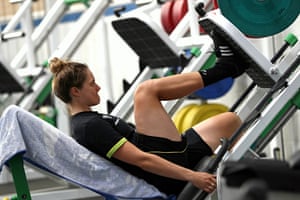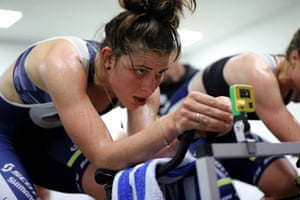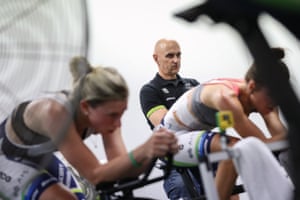Cadel Evans AM. Stuart O’Grady OAM. Bradley McGee OAM. Katherine Bates. These are just some of the high-achieving former Australian cyclists whose images adorn the Champions Walk at the High Performance Unit (HPU) in Adelaide.
Every day, when Australia’s current generation of cycling stars arrive at their training base, they must pass these photos as they descend into the bowels of the velodrome. Inspiration and pressure, in equal measure.
Run by governing body Cycling Australia with funding from the Australian Institute of Sport (AIS), the High Performance Unit is a hub for elite track, road, BMX and para-cycling riders in this country. While the demands of road and BMX competition necessitates that these athletes are often based overseas, the centre is Australian track cycling’s undisputed home.
Nestled on the outskirts of town close to the cycling-friendly Adelaide Hills, the facility brings together the nation’s top athletes and support staff with a single-minded focus: sporting glory. Australia has long been a cycling superpower, and track riders are consistent contributors to the green and gold Olympic medal tally. At London 2012 five medals were earned in the velodrome, while the Australian Olympic Committee is expecting the discipline to deliver three golds in Rio this August.
Track competition is increasingly an arms-race of marginal gains, a concept popularised by British Cycling that promotes the cumulative benefits of small improvements to every aspect of a rider’s preparations. From innovative training regimes to sleeping in the right position, “they’re tiny things but if you clump them together it makes a big difference” according to coaching doyen Dave Brailsford. In this new era, the work done at the HPU may well mean the difference between success and failure for Australian cyclists in Rio.

‘No-one funds you to go slowly’
One half of the High Performance Unit is inconspicuous. The office area, where coaches and staff work at desktop computers, is like any other – a sign in the kitchen even warns that “the cleaning fairy is on strike, clean up your own mess”. Aside from the occasional item of sporting memorabilia adorning the wall, this predominantly open-plan space is indistinguishable from that of a professional services firm. The 30 or so employees here, though, are united by an unusual common goal.
“There is a huge value to having all the different service areas integrated in the one place,” says dietitian Olivia Warnes. “We all have our role, and each area – nutrition, strength and conditioning, physiology, psychology – is incorporated into every athlete’s plan. This means that things are done efficiently and effectively, and the riders are confident that we are all working towards the same objective of Olympic success.”
The history of the Unit is also atypical. Australia’s initial foray into elite sporting programs, through the AIS, was born out of failure: the nation performed so poorly at the 1976 Olympics that it caused a political scandal. In contrast, the High Performance Unit began with triumph.

“The thrust forward came out of the 1984 Olympics, when [legendary but divisive coach] Charlie Walsh and his charges won a team pursuit gold medal in Los Angeles,” explains current national performance director Kevin Tabotta, who has been at the helm for five years. “There had been some activity prior with the South Australian Sports Institute, but essentially the structure we have now was born following 1984.”
Fast forward almost three decades and Olympic sports in this country were thrown into turmoil by the Australian Sports Commission’s 2012 Winning Edge strategy, which divested direct control of elite training programs from the AIS to individual national sporting organisations. While the reform was little felt in Adelaide – Tabotta indicates that it had an “almost negligible impact” – the increasingly performance-oriented approach to funding has placed greater emphasis on results. The unit’s very existence in its present form is accordingly dependent on continued success in Rio and beyond.
Yet Tabotta has no qualms with the new model. “No-one funds you to go slowly,” he laughs. “If you want to retain or increase your government funding, logic says that you need to succeed – not just on the track but by demonstrating high performance across all elements of your operations.”
‘The riders learn so much about themselves and each other’

Despite the magnitude of his achievements, Gary Sutton OAM is approachable and understated. Brother of the controversial technical director, Shane Sutton, the 61-year-old enjoyed a glittering road and track cycling career – including 43 national titles, a Commonwealth Games gold medal and the world point score championship – before becoming a respected coach. Rio 2016 will be his sixth Olympics: two as an athlete, two as a commentator and now two as a coach.
Sutton is in charge of the women’s track endurance squad, a group of six riders focused on the team pursuit event. He is tireless and dedicated, failing to comprehend a question about the extent of his working week; Sutton has a seven-day schedule and rarely takes time off. “I love this job,” he eventually responds.
While the athletes nominally have Sundays free from training, performing at such an elite level requires complete commitment. “Even for the riders it is a seven-day week,” Sutton explains. “They enjoy their day off, but it is normally when they get a massage and do recovery.”

This all-consuming nature of the sport puts great mental and physical strain on the athletes. “It can be tough,” admits Olympic bronze medallist Annette Edmondson, whose brother Alexander is also at the HPU. “We train in the morning, put our feet up to recover, and come back for more training in the afternoon. Then we eat and go straight to bed! It is all about the bike.”
Yet such an environment is also conducive to the creation of strong bonds among riders. Despite spending six days a week training together, the endurance squad still make time for regular team dinners. It is only slightly clichéd to call those at the unit a cycling family.
“We spend more time with each other than with our own families,” observes high-flying sprinter Stephanie Morton OAM, who won gold at the Commonwealth Games in Glasgow. “We have games nights and the boys play golf together. It makes the road to Rio much easier – when things get tough you can rely on your team-mates.”
The personal closeness of the endurance squad was evident last year when one rider, 21-year-old Georgia Baker, tragically lost her father to a heart attack. “All the girls and the staff were very supportive,” says Baker. “They did not wrap me up in cotton wool, but they were always there when I needed help. They are not only my team-mates, but my friends.” The residential nature of the program – the sprinters are permanently based in Adelaide, while the endurance riders spend most of their time here – only strengthens this team ethos.
For coaching staff, maintaining the optimal relationship with riders is no easy task. “We are a close team, but we try to stay one step removed – we need to remain objective,” adds Dr Katie Slattery, a sports scientist. “We are here to help them become the best athletes they can be, not to be their friend.”
The staff must be detached because they need to select the best possible competition line-up, and often riders are left at home. Sutton confesses that once he has decided on his travelling squad for Rio (one team member must miss out), he will endure several sleepless nights before breaking the news. Having trained for years towards this goal, being overlooked is a crushing experience for an athlete.
Senior performance psychologist Dr John Baranoff and his colleagues are regularly on hand at the HPU when things do get tough and riders confront mental pressure. Working with a wellbeing coordinator and personal excellence advisor, his role extends from high-level performance training (“planning and preparation, use of constructive thinking, regulation of emotion and other psychologically-focused performance enhancement strategies”) to the seemingly mundane (“finding them accommodation, monitoring the impact of relocation, identifying their support networks”).
Baranoff is just one cog in this complex and multifaceted machine. By locating the support staff in the same building as the velodrome and training facilities, the unit ensures close cooperation and prevents – to use the words of champion sprinter Matthew Glaetzer – any “athlete/staff divide” in the pursuit of Olympic triumph.
Yet there is also another important objective. Sutton explains: “We might all be focused on Rio, but this program is also about personal development. The riders learn so much about themselves and each other, I believe they leave here as better people.”

With the difference between gold and the rest in track cycling sometimes as small as one millisecond, innovation is essential for ensuring continued success at the High Performance Unit. While the extensive coaching experience on hand serves the athletes well – “most of the staff here have been through several Olympics,” says technical director Ian McKenzie – adding fresh perspective prevents stagnation.
“We are always looking for innovative ways to improve,” declares sports scientist Slattery, who joined Sutton’s team in late 2014. “Whether it be heat training, altitude training or just working with all the other staff to make sure we are not missing out on any opportunities.”
Nutritional supplements are another target area in the strive to achieve marginal gains. “A big focus in track cycling has been at the pointy-end with performance supplementation – supplements can be the little one percenters,” says dietitian Warnes. While she stresses that “Cycling Australia has a really sound supplement policy,” it is a delicate subject given the doping issues which have plagued the sport.
Innovation often comes with risk, and the coaches in Adelaide are no strangers to taking a gamble. Canberra-based Rebecca Wiasak was a late entrant into the sport, initially joining the unit as a 29-year-old following a stint as a sports journalist. But her unorthodox selection paid off in spades when Wiasak won consecutive individual pursuit world championships.
“Sutto [Sutton] invited me to camp because of my initial road racing results, not because of any track background,” she explains. “I have been looked after incredibly well during the past three years – Gary has done everything he can to get me in the best possible spot to be selected for the Olympics.”
Asked how else the unit can continue to improve, its leader provides an honest assessment. “Incrementally, and it is not always a linear progression,” says Tabotta. “We have been on a strong trajectory for the last two decades. It is no secret though that more resources help you perform. We can talk about efficiencies, good people and good planning, but none of that matters without a base level of funding.”
These financial limitations dictate an almost singular focus for staff across the HPU, which necessitates that primary responsibility for developing young riders must be left to state sporting institutes. With funding criteria based predominantly on short-term indicators, investment to future-proof the program can paradoxically put at risk present success and thereby jeopardise the entire operation. Although the unit does run several youth programs, the centre of attention at the present stage of the four-year cycle is obvious.
“Right now we are 95% focused on the Olympics,” says strength and conditioning coach Dr Kristie Taylor. “We are still in contact with the younger athletes coming through the system at state-level, where most of the development happens, but we are predominantly focused on getting gold medals in Rio.”

While the HPU was open and accessible during Guardian Australia’s visit, an element of secrecy lingered. The marginal gains arms-race has led to intense competition between different national programs: specific questions about preparations ahead of Rio were answered off the record and certain equipment could not be photographed.
Yet in this new era, where every aspect of performance can be quantified and improved upon, one intangible stood out in Adelaide: the vibe. Notwithstanding a degree of collective stress enveloping the HPU with the Olympics imminent, athletes and staff alike were cheerful and friendly. Given the amount of time riders spend at the unit, it is unimaginable that this atmosphere would not have a constructive impact – another marginal gain.
Max Stevens, a former AFL player agent with the mysterious job title of “Special Projects”, credits the coaching team. “Working in the positive culture created by the likes of Gary, Kevin, Ian and [head sprint coach] Gary West is fantastic,” says Stevens. “Whether you are the cleaner, the administrator or the director, you cannot help but give it your all here. They have created an atmosphere of high performance.”
Cycling, like many other athletic pursuits, is a sport which ordinarily emphasises the individual. The Champions Walk is testament to that – while there are several snaps from various team victories, high-profile riders are predominantly pictured alone. The entrance by road to the Adelaide velodrome – Anna Meares Way – is even named after a lone rider, one of Australian cycling’s most successful.
Yet the resounding message from the visit was that of team-work, on and off the track. If Meares or her colleagues win Olympic gold in August, their success will be attributable to more than just individual brilliance and perseverance. Behind them is a dedicated team ensuring that they have every chance to succeed come Rio.
“Together,” Sutton concludes, “everyone is looking for the winning edge.”



